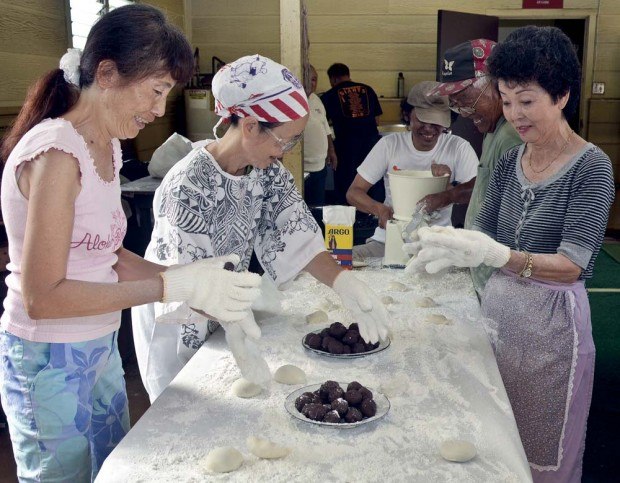KAPA‘A — Mochi is eaten on special occasions in Japanese culture, and today’s celebration of Boys Day is no exception. The Kapa‘a Jodo Mission was working diligently Sunday to keep the tradition alive on Kaua‘i. The process starts in the
KAPA‘A — Mochi is eaten on special occasions in Japanese culture, and today’s celebration of Boys Day is no exception.
The Kapa‘a Jodo Mission was working diligently Sunday to keep the tradition alive on Kaua‘i. The process starts in the wee hours of the morning when members report to the church to prepare the stoves for cooking the sweet rice.
“We don’t usually make that many mochi for Boys Day,” said Wesley Hayashi, who was manning the battery of heavy steel home-made stoves, steaming the mochi rice in wooden containers. “This year, we’re just making 300 pounds of rice. New Year’s mochi is more than double that amount.”
Over the years, age has taken its toll as members mature and few young people step in to help.
During New Year’s, considered by Japanese to be one of the most significant celebrations of the year, mochi is eaten in various forms including ozoni, a soup featuring mochi and other symbolic foods for New Year celebrations.
Girls Day, or hinamatsuri, is celebrated on the third day of the third month, and mochi for that occasion is usually sweet and colored in pastel shades of pink and green, a church volunteer said.
The hinamatsuri mochi are formed into diamond shapes as opposed to the circular cake shapes for New Year’s and Boys Day.
Responsibility for making the mochi is spread out across various stations, including washing the rice, cooking, manning the mochi machine, and creating the mochi.
Inside the temple, other volunteers are divided into weighing and packaging the mochi and still another group works on cooking up food for the volunteers.
Celebrated on the fifth day of the fifth month, Boys Day marks the end of the holiday period known as Golden Week in Japan, states the Tokyo Made Simple website.
Boys Day was the traditional celebration in Japan, but in 1948 the name was changed to Kodomo no Hi, or Children’s Day, to reflect the politically correct thinking.
Despite the name change, the masculine nature of the celebration continues and has many festive events tied to it.
The most common symbolism of Kodomo no Hi is the strings of koi, known in Japan as koi nobori, flying above rooftops, hanging from house windows, and in Japan’s countryside, even strung out over rivers.
Koi, or carp, is the symbol of strength, stamina and drive the fish demonstrates as it swims upstream against the river’s current. Families who have boys flying the koi nobori above their homes are expressing their wish to have their male children grow strong and to be able to successfully face life’s challenges.
In addition to the koi nobori, Kintaro dolls are displayed. The Japanese folk hero’s strength and bravery bring him to the status of warrior. Families display Kintaro dolls and kabuto, or armor, as an expression of their wish for sons to grow to become successful.
Traditionally, Kashiwamochi, or mochi filled with azuki bean paste and wrapped with either oak or bamboo leaves, are also enjoyed on Boys Day. This arrived in Hawai‘i with Japanese immigrants who were brought here to work in the plantations.
• Dennis Fujimoto, photographer and staff writer, can be reached at 245-3681 (ext. 253) or dfujimoto@ thegardenisland.com.



